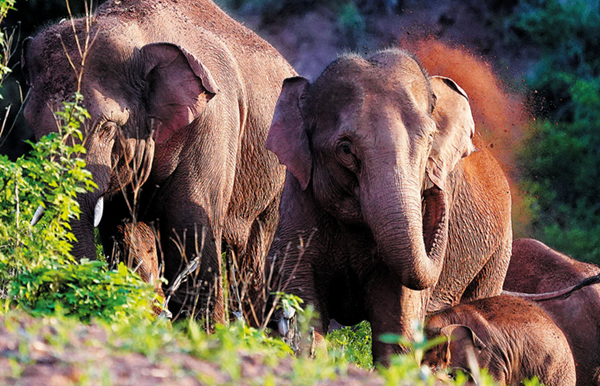
A herd of wild elephants that trekked northward for months last year was recently spotted entering Wild Elephant Valley in Yunnan province's Xishuangbanna Dai autonomous prefecture.
"The adults and babies in the herd are all in good health," said Chen Fei, director of the National Forestry and Grassland Administration's Asian Elephant Research Center.
The herd still has 14 members, but Chen said that could include some new members as it probably came into contact with other groups along the route.
"We have not introduced electronic identity chips for elephant monitoring," Chen said. "Observers usually recognize different groups based on their years of experience and some special features on the elephants' bodies."
He said observers in the valley will continue to monitor the herd's activities.
After the herd left its traditional habitat, three members dropped out and two calves were born en route. It headed north with 14 members in April.
Its long journey-passing through eight counties and even approaching the provincial capital Kunming, home to some 8 million people-took the internet by storm.
Local authorities deployed trucks, workers and drones to monitor the elephants around the clock, evacuated roads so they could pass safely and lured them away from populated areas with food.
In September, the herd returned safely to its habitat. No injuries to people were reported along its route.
Wild Elephant Valley, the prefecture's largest wild animal rescue center, was established in 1996. In the dry season, from October to May, large numbers of wild Asian elephants visit the valley's riverbanks.
"Xishuangbanna has entered its dry season. Wild elephants come here in groups to communicate with each other," said Chen Jiming, an elephant caretaker in the valley.
He said three herds of about 30 wild elephants had been spotted around the valley by Feb 20.
Yunnan is the only place in China where wild Asian elephants are found. They live in the south of the province-in Xishuangbanna and the cities of Pu'er and Lincang.
The Asian elephant, which is included on the International Union for Conservation of Nature Red List of Threatened Species as "endangered", enjoys Class-A protection in China, the same level afforded to the giant panda.
Thanks to determined protection efforts in recent decades, the Asian elephant population in China has risen from 170 in the 1970s to 300, according to the Yunnan Provincial Forestry and Grassland Administration.
Yunnan has established 11 nature reserves with a total area of 414,600 hectares, nearly double the amount in the 1980s. The province has also piloted the use of elephant canteens to solve the problem of human-elephant conflict.
The provincial government plans to develop a national park this year to further protect elephant habitat.
According to a work plan released by the prefecture government on Feb 21, Xishuangbanna will initiate a project in Mengyang county in the next five years that will isolate human settlements from elephant habitat to prevent conflict.
The prefecture will also continue to promote the construction of bio-corridors connecting China with Laos and Myanmar, expanding the elephants' habitat and boosting the species' gene pool.